This document serves as a comprehensive guide and detailed instruction manual on the gold standard for golf course bunker construction methods: Capillary Bunkers. It covers the intricacies of creating durable, weather-resistant bunkers that enhance the play of golf. From the very first digging to the application of the final layer of sand, this manual addresses all aspects of the golf bunker installation process.
The significance of choosing a high-quality bunker liner can not be stressed. A proper liner is crucial for maintaining the bunker's shape and depth over time and plays a vital role in moisture management. It ensures efficient drainage of rainwater, preventing sand washout and structural erosion. The Capillary Bunker liner is the only choice to facilitate this over the next +25 years.
Effective bunker drainage is presented as a critical component of the guide. A well-designed drainage system is essential for keeping bunkers playable, preventing water accumulation, and preserving the course's integrity in adverse weather conditions.
This guide is intended to provide the necessary knowledge and tools to improve the quality and aesthetics of golf courses through the construction of expertly designed bunkers, by using our golf bunker construction method.
The Capillary Material is a patented product to build sports ground profiles. Here we will cover the use and method of it as a bunker liner. The Capillary Material, is a specially formulated mixture of acceptably sized aggregate, various proprietary additives and water that comes pre-mixed, delivered in a concrete truck. The product is a homogeneously blended mixture that is poured from the mixer into heavy-duty utility vehicles, transported to the bunker, and placed inside the bunker at a minimum depth of 2 inches(50mm). The surface of the product is compacted with a roller and covered in plastic for a minimum of 24 hours to allow for adequate curing and until sand is placed on top of the product. The result is a strong, homogenous, and uniformly-bonded bunker liner base that allows for rapid drainage of any rain-storm and also reduces wash-outs and/or contamination of bunker sand.
Prior to installation of the Capillary Material, the Contractor, Owners Representative, or Superintendent shall confirm that the perimeter area around the bunker does not channel excessive water into the bunker area, that the bunker sub grade is positively pitched, stable under foot, smooth, compacted, free of debris, and meets the Architect’s design specifications. It must also be ensured that all bunker trenches have been excavated and constructed to specifications; and that drainage pipes and bedding gravel (table 1) have been installed to the Architect’s drainage specifications as dictated by site conditions. At the lowest point of the bunker sub grade, a 2” x 2” wood frame at least 2 feet long and 2 feet must be placed prior to installing the Capillary Material, If the bunker floor is large and flat, several frames must be placed to ensure that any point of the bunker floor which is less than 6 inches above the lowest point is located no more than 6 feet away from a frame which will create the drain Vaults filled with bunker sand, see page 3. This is to ensure the sand depth at the lowest points of the bunker is always enough to keep the sand dry at the surface.
The Capillary Wash Box is an optional, complementary product, to Capillary Bunkers. If the Capillary Wash Box is installed, it is placedin the Vault, on top of the drain line, before sand or Capillary Material is installed. This Patent Pending box is placed in the low point ofthe bunker, on the drain line, to allow for the bunker sand to be washed clean should there ever be any contamination from outside ofthe bunker (soil, dust, grass etc.).
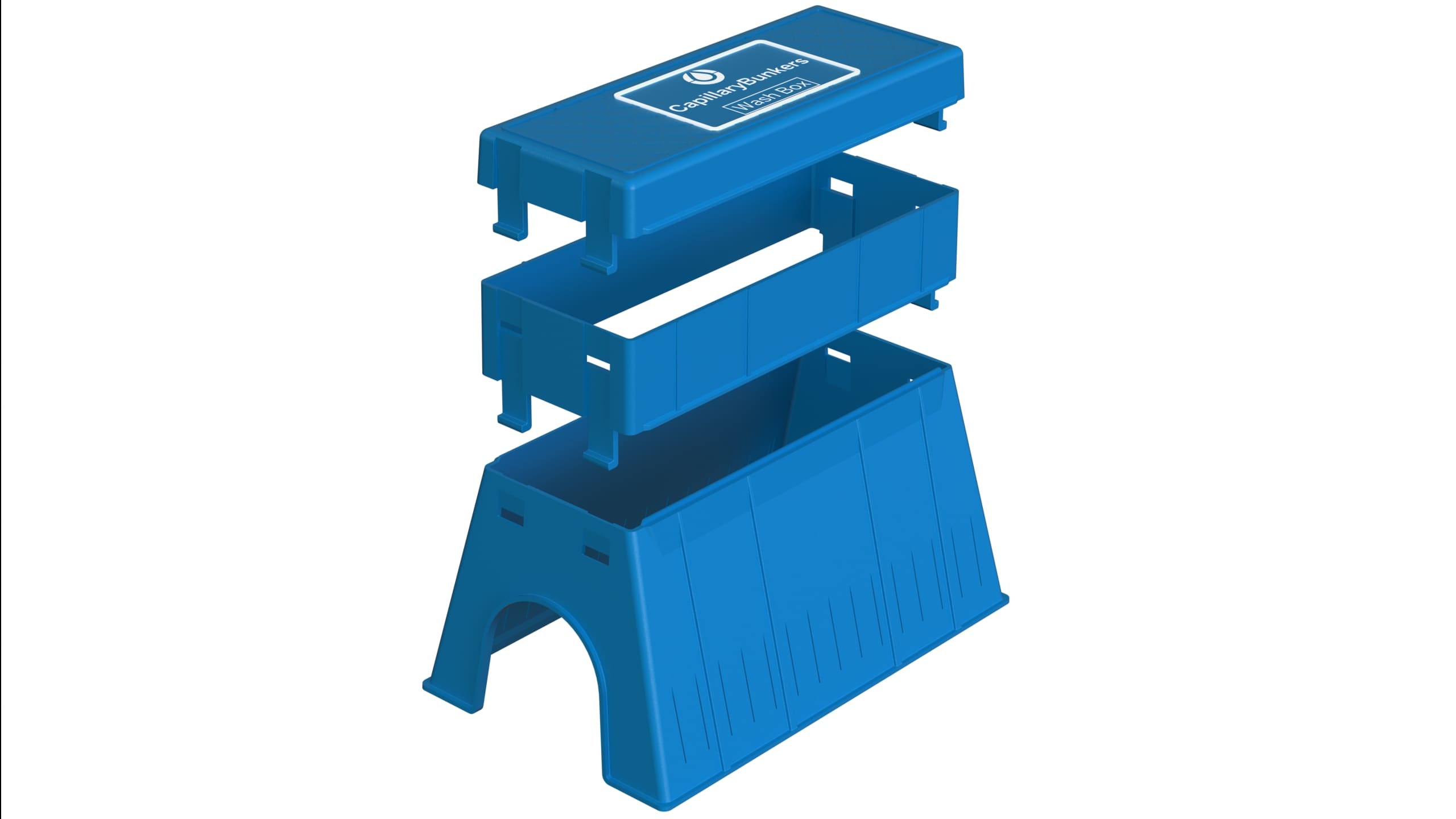
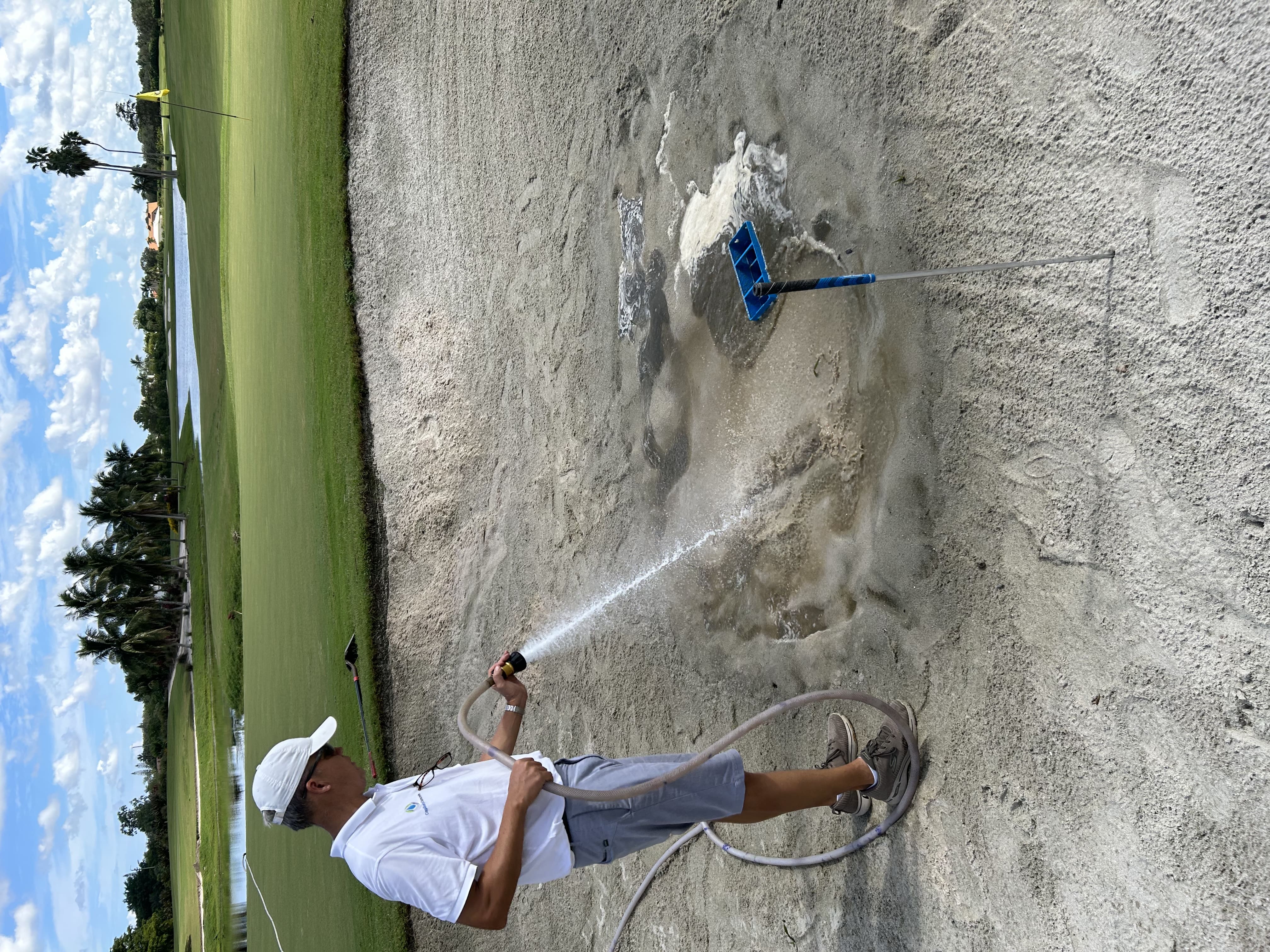

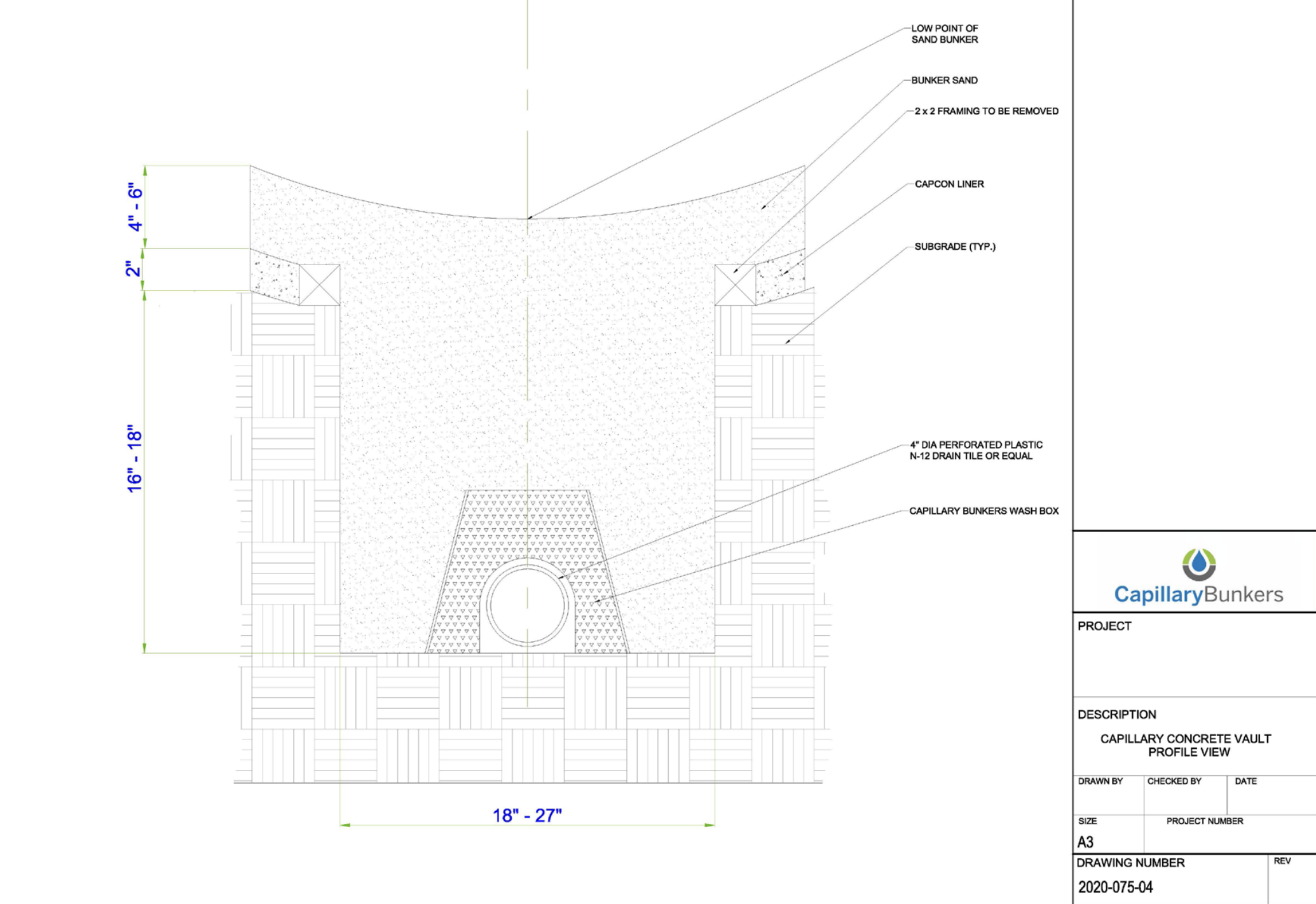

To maintain the nature of the product, every effort should be made to prevent soil contamination of the Capillary Material during installation, curing, and prior to sand installation. Two methods to safeguard your installation from contamination:
With this method, it is recommended that turf grass around the perimeter of the bunker should be secured to the soil by roots or staples before the installation of Capillary Material. After installation and curing and a water test has been performed to ensure drainage function, sand can be installed in the bunker. For newly sodded bunkers, where additional irrigation is required for rooting and establishment, we recommend that a thicker layer of sand (approx. 8-10 inches highx 10 inches wide) be installed on inside perimeter of the bunker against new sod. This is done to allow the sand to actas a filter layer to catch any soil runoff during irrigation cycles on the newly placed sod. Once the sod is establishedand irrigation cycles are reduced, any contaminated sand around the perimeter should be removed. Bunker sand canbe leveled and normal bunker maintenance practices can begin.
In situations where grass cannot be installed prior to the installation of Capillary Material, extreme care must be used to prevent soil contamination. Sand should be installed immediately after curing and the water test. As in method 1), a thicker perimeter layer of sand should be installed to reduce soil contamination prior to sod placement. After establishment, any contaminated sand around the perimeter can be removed.
The edge detail often gives the bunker shape its distinctive style. The Capillary Material has the unique ability to be formed to fit any Architects design goals. Preserving the desired style or motif and reducing ongoing maintenance is critical to the success of any bunker restoration/renovation plan.
The strength of the Capillary Material allows the opportunity to protect the inside wall of the bunker better than any other product. The Capillary Material has the ability to be shaped almost vertically at installation to get the least possible amount of soil in contact with the bunker sand. In this photo the sub grade under the existing turf has been excavated 3-4 inches and a layer of Capillary Material has been placed under the sod to help protect the edge from collapse and contamination. Sand is pulled up the face to hide the Capillary Material edge.

In this case, either the existing soil and grass, or sod is utilized as the edge of the bunker. The 2-inch (50mm) layer of Capillary Material meets the edge of the bunker. Rolling the sod over the face to cover the soil is an option.
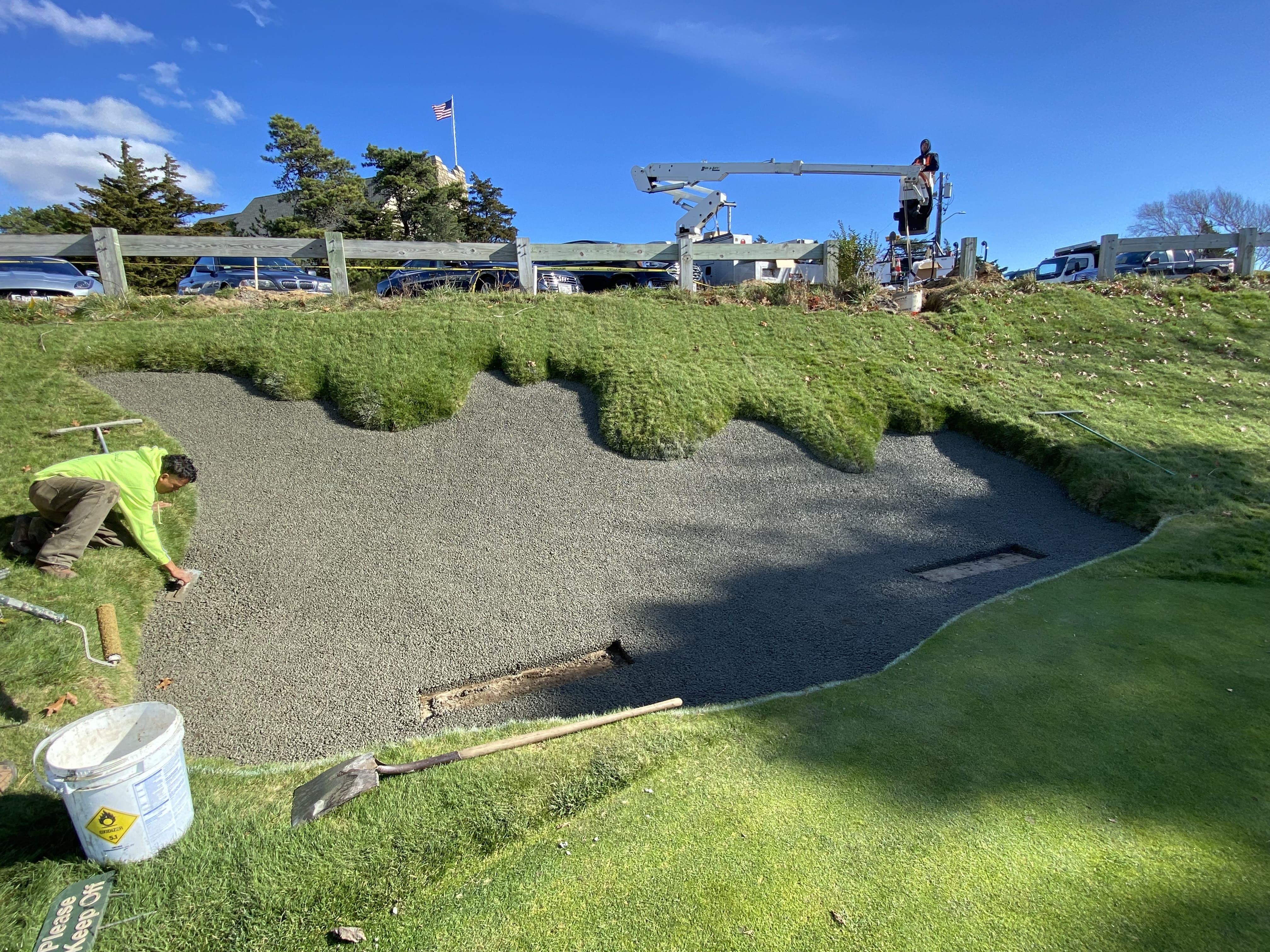
Here, a thicker piece of sod is cut and laid on the side on the prepared bunker floor to create the inside edge of the bunker.Cut the sod as wide as you want the edge high, and then backfill with soil and tie into the outside shaping of the bunker. Regular sod can then be placed to cover the soil and tie into the outside of the bunker.
A shelf is created with a trowel and carefully compacted on all sides. A minimum of 2 - 3 layers of artificial turf is recommended, butany number of layers can be built. If only natural sod is used it is necessary to place an impermeable plastic on the shelf to keep thesod from drying out too much. Backfill with approved materials according to the specifications from the Eco Bunker manufacturer.This provides a stable edge option with very little contamination risk.

The Capillary Material has an open structure that allows water to freely drain through it at more than 100 inches per hour. Once sandis placed on top of the product, the new water drainage limit will be the Ksat (saturated hydraulic conductivity) of the sand that covers the Capillary Material. After gravitational water has freely drained from the sand, a certain amount of water will always be retained in the sand against the force of gravity. This is known as capillary water and the amount can be determined with a Soil Moisture Release Test by an accredited test lab. Every different bunker sand has its own unique amount of capillary water retention based on the amount of moisture present in the sand. If the Capillary Wash Box is installed, the sand can be modified and finer particles in the sand at the base of the bunker can be removed. Never use a sand that is not an approved USGA sand. For more information on selecting the perfect bunker sand we recommend this information from the USGA: https://www.usga.org/content/usga/home-page/course-care/green-section-record/58/11/a-guide-to-selecting-the-right-bunker-sand-for-your-course-.html#returnable.

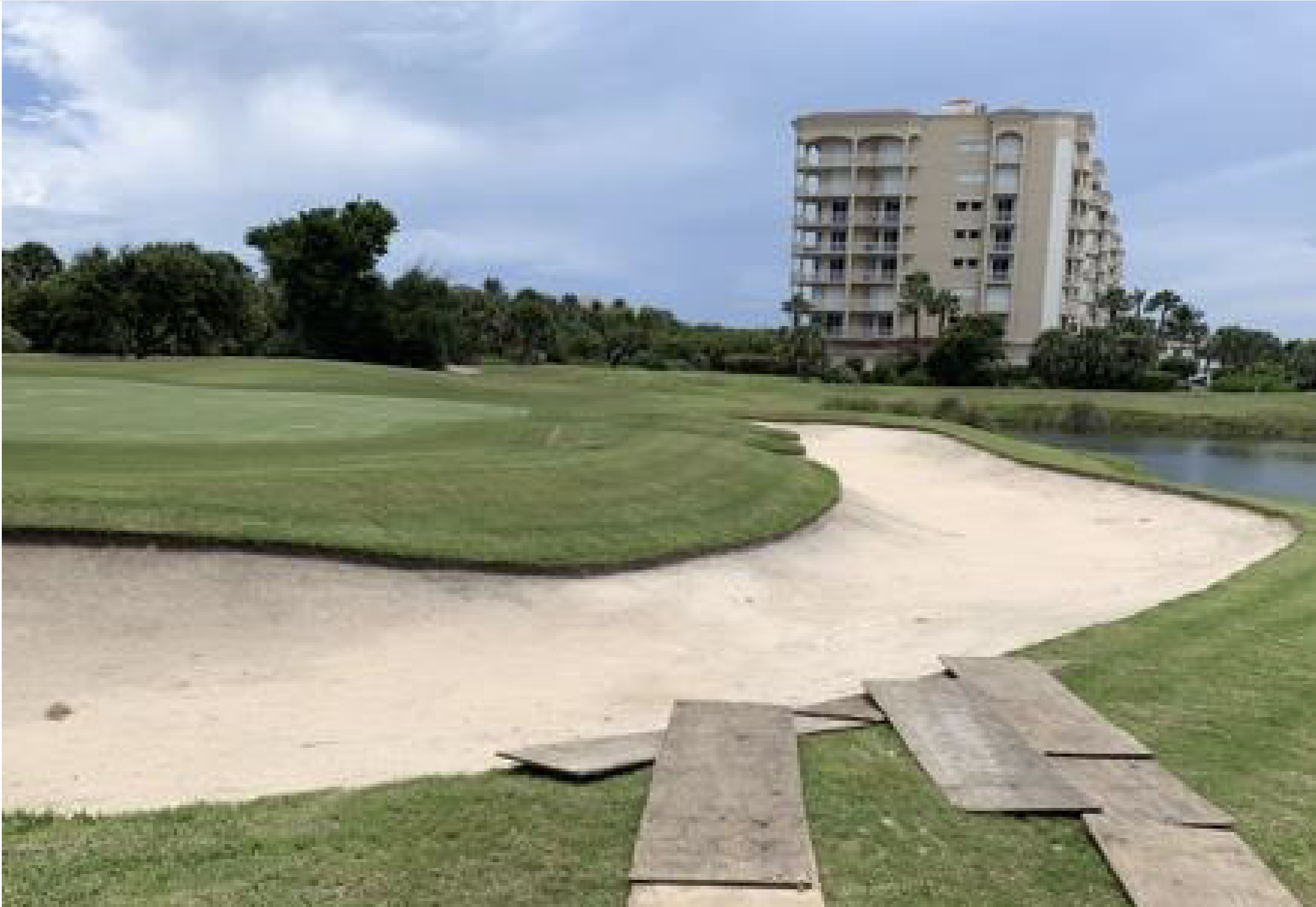


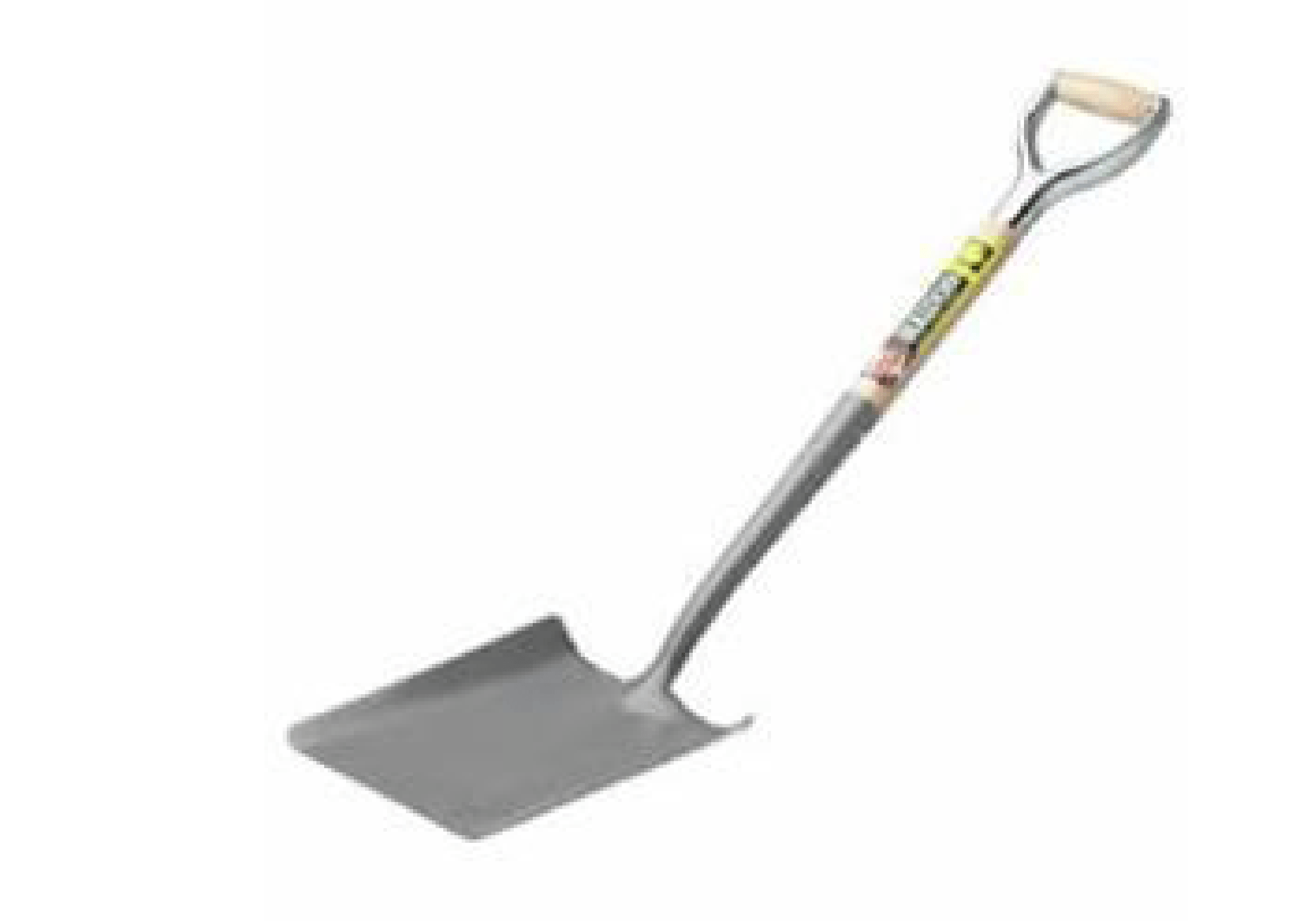

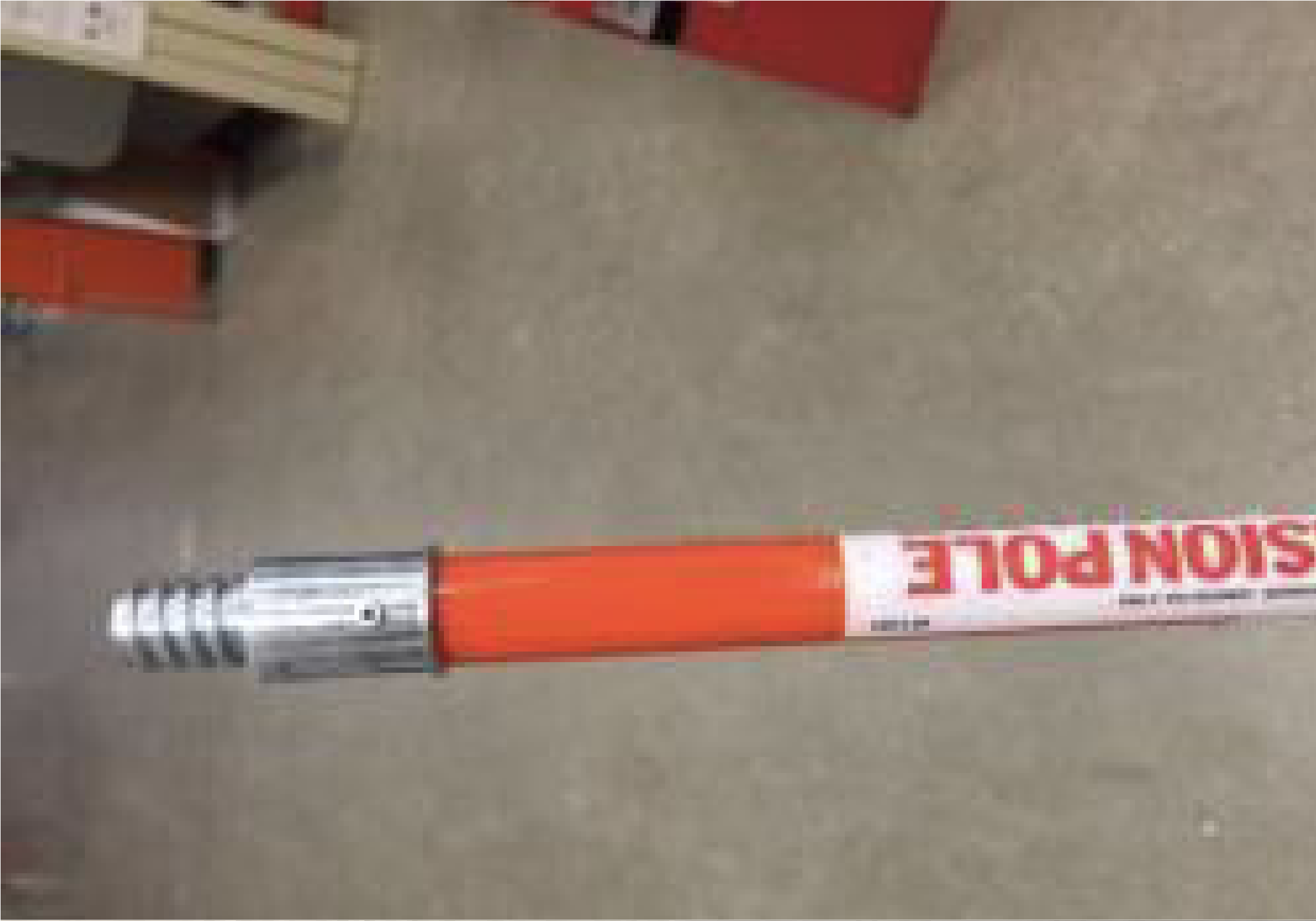


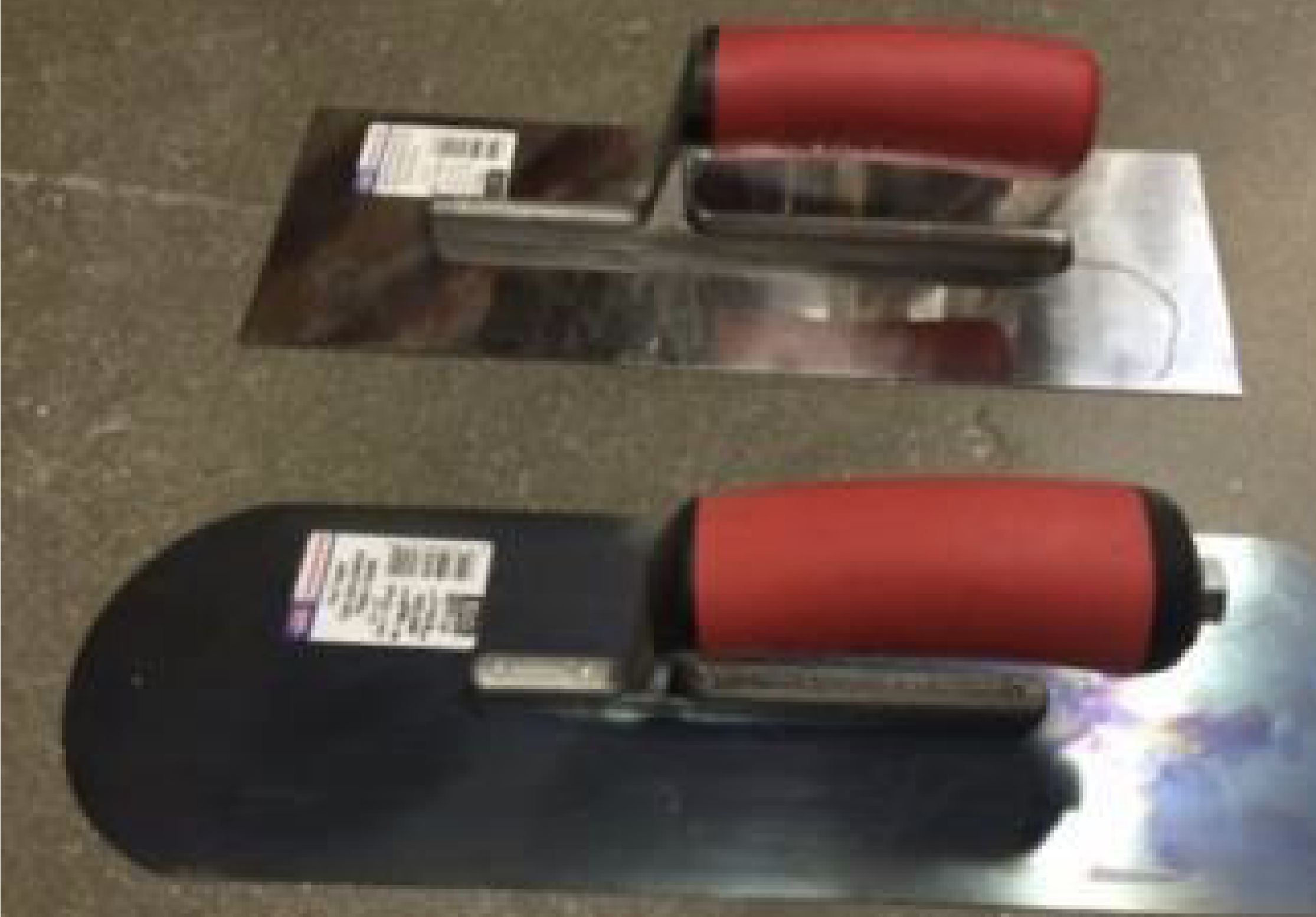





The Capillary Material should not be installed when daily high temperatures are expected to be below 40 degrees (F) or below 36 degrees (F) within 2 days of installation. During hot weather, windy, or low humidity conditions, the product will set up faster and caution must be exercised to maintain acceptable moisture levels of the mixture and bunker base prior to installation. A light misting of the bunker subfloor may be required several times during the installation process.

When the ready-mix truck arrives at the job site, you will need to ensure the correct consistency of the Capillary Material before installation can begin. Before discharging any mix, ask the driver to spin the truck 25 revolutions to adequately mix the product.(It’s been mixing since it left the plant, but we find this to be a good way to ensure mix uniformity)Now it’s time to perform a HAND SQUEEZE TEST as shown here. Ask the driver to discharge a small amount of the Capillary Material mixture into the utility vehicle you are using to haul the mix to the bunker. It should be shiny and look like melted chocolate and rock. Take a handful of the mix and squeeze it in your hand and release. The paste must be creamy and sticky enough for the aggregate particles to adhere to the vertical surface of your hand. If the paste is dry and powdery, the mix is a little too dry and you need to ask the driver to add water to the mixer truck. Never add more than 1 gallon of water at a time (unless otherwise instructed by an onsite CapillaryFlow representative), check after, ask the driver to turn the drum a minimum of 15 revolutions before checking the mix again. Continue this process until the mix has the feel of melted chocolate. Be careful not to add too much water. It’s always better to add a little at a time.We cannot take the water out once it has been put in the mixer. The paste should NEVER be drippy and runny when you perform the hand squeeze test. The mix should always have the consistency of melted chocolate. Continue to monitor the consistency as you install- YOU MUST perform the hand squeeze test occasionally to ensure consistency during the installation. An additional gallon of water maybe required after a few loads have been installed. If so-ask the driver to add one gallon and rotate the drum 15 times before discharging more mix. If the mix is extremely wet and runny when the ready-mix truck arrives, ask the driver to spin the drum for 5 minutes to try to dry the mix up a bit. If that doesn’t work and the discharged pile for testing has clogged up void space, you should refuse the truck, send it back to the plant, and contact your CapillaryFlow Representative immediately. DO NOT install the Capillary Material if the mixture is too wet.
If the subgrade is dry, it should be lightly misted prior to placement of the Capillary Material. Do not let the floor get muddy during installation, and make sure floor is always smoothed out before installation of the Capillary Material. NEVER WALK ON THE WET CAPILLARY MATERIAL MIX.
Once the batch is properly mixed, begin in one corner of the bunker by spreading the mix to a depth of 2 inches (50mm) (using depth gauge rings). Use plastic bunker rakes or the aluminum placer tools to drag out and level the product. DO NOT walk on the product in the bunker. This will compress the product and restrict water flow. We want to preserve as much open space for water flow as possible.

Use the textured roller or trowels to finish and lightly compact the surface. The entire surface of Capillary Material must be lightly compacted to provide a smooth surface and bond the product together. Keep the roller damp during the rolling process. It is important to work quickly during this step. The sooner the product is smoothed and rolled the better.

The edge of theCapillary Material must be no less than 2 inches thick. A hand trowel should be used to compact and finish the edge of the material around the bunker edge (If desired, this is also the location of the drip-line irrigation option). Care must be given to prevent loose aggregate pieces from adhering to the exposed soil edge.Any loose pieces should be removed immediately.

Once an area or batch section is finished, it must be covered immediately with 6 mil plastic. Black plastic is preferred on cold days, clear plastic is preferred in the summer.Covering is important to reduce moisture loss and improve curing and strength of the mixture, and covering MUST BE performed in any weather. Place staples in the plastic every 3 feet around the perimeter of the bunker and as close to the mixture as possible to reduce air between the plastic and mix. If there are seams between plastic pieces, use something heavy to hold the seams down. Remember we want to reduce the amount of air getting to the product as it cures. This step also keeps debris and water from getting onto it during set up.
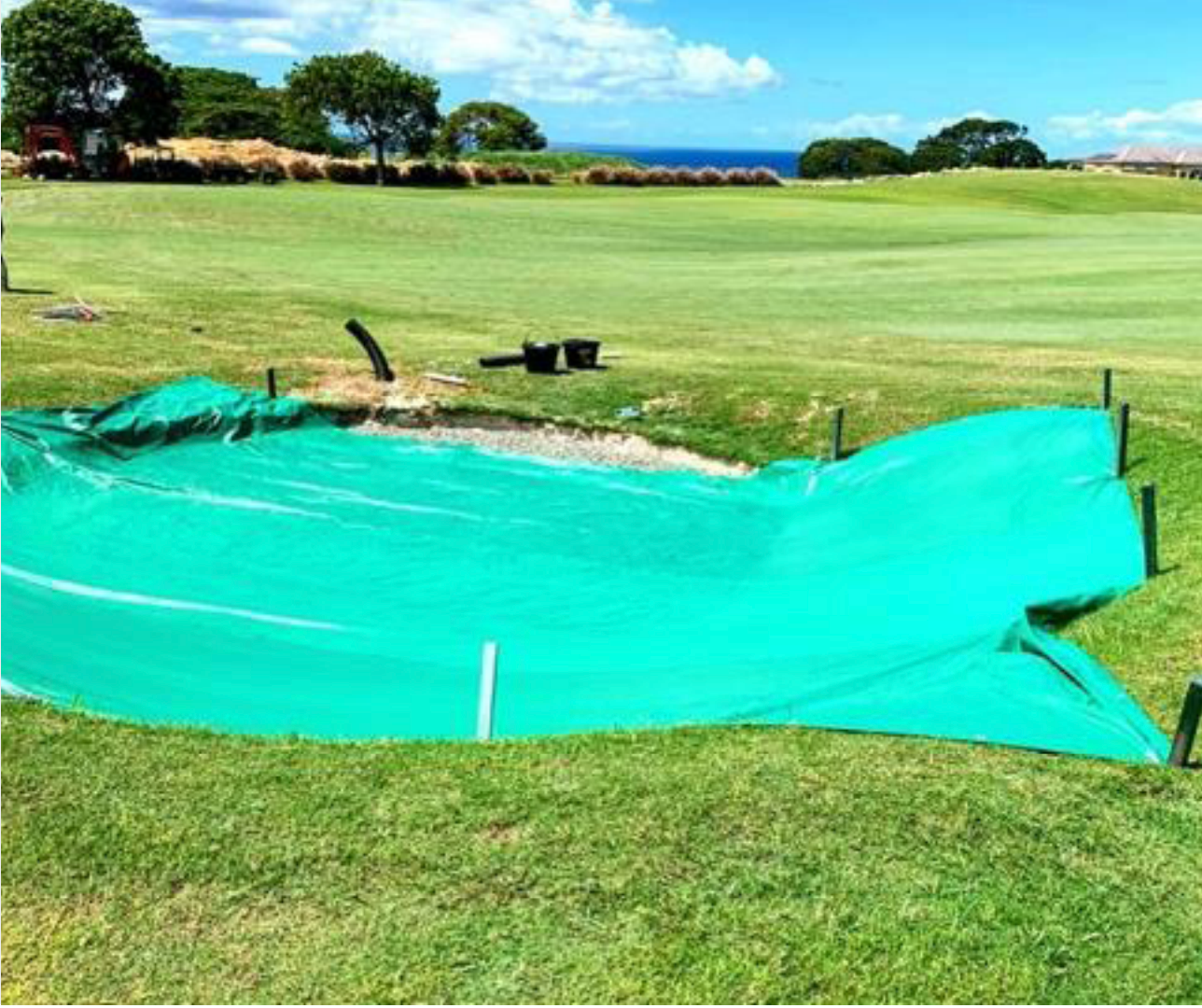
The plastic cover must remain on product for a minimum of 24 hours (48 hours incold or wet conditions). Then, remain covered until bunker sand can be installed.This helps the product cure and will keep the product clean and debris free.
Before installing the bunker sand (minimum of 24 hours after installation mustpass), remove the plastic and clean the base of the bunker with a backpack blowerto remove any loose surface pieces that may not have adhered during the rollingphase of the installation. Check the edge for loose pieces as well and remove themfrom the soil edge. Do not allow concrete to turn light-grey in color. The productneeds to stay hydrated before sand is applied, if not keep covered.

Now perform the water drainage test to confirm that water rapidly drains throughthe product. This must be done to activate the Performance Guarantee. Do not“blast” high pressure water on the freshly installed Capillary Material - a showerspray is preferred over a steady stream.
Bunker sand can now be installed (using a conveyor, loader, or utility cart etc.) to the required or specified depth according tothe Soil Moisture Release Curve. Do not drive directly on the new CapillaryFlow bunker during sand installation. It is recommended to begin sand installation on an edge and push the sand out across the bunker using a sand rake or similar machine while keeping vehicles on plywood on top of the sand layer. Once the sand has been installed, saturate the sand with a spray nozzle so asto not flood the sand to where fines can separate. This moisture will help the product continue to cure and help the sand firm up.
If requested by the Contractor, Owner’s representative, Superintendent, or Golf Course Architect, CapillaryFlow will provide a technical representative for installation assistance and consultation for one (1) full day on site at the startup of a Capillary Bunkers installation for the cost of basic expenses and related costs. Additional days of consultation may be requested at the same expense rate.Please provide a minimum two (2) weeks’ notice to arrange this service. For more specific questions, contact CapillaryFlow.
